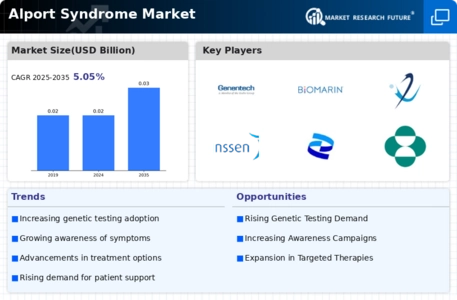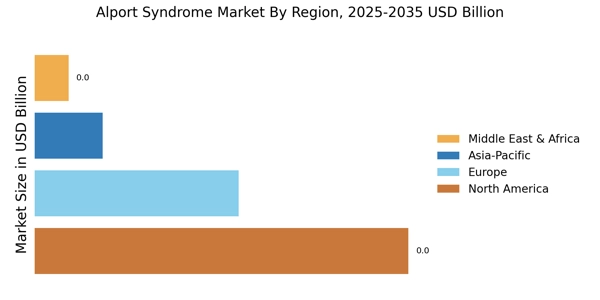Advancements in Genetic Research
Advancements in genetic research are significantly influencing the Alport Syndrome Market. The identification of specific genetic mutations associated with Alport Syndrome Market has paved the way for more precise diagnostic methods and targeted therapies. As research continues to evolve, the understanding of the genetic underpinnings of the disease is likely to enhance treatment options, potentially leading to the development of personalized medicine approaches. This shift towards genetic-based therapies may attract investment and interest from pharmaceutical companies, thereby driving market growth. The integration of genetic testing into routine clinical practice could also facilitate earlier diagnosis and intervention, further impacting the Alport Syndrome Market.
Rising Prevalence of Alport Syndrome
The increasing prevalence of Alport Syndrome Market is a notable driver in the Alport Syndrome Market. Recent estimates suggest that the condition affects approximately 1 in 5,000 individuals, leading to a growing patient population requiring specialized care. This rise in prevalence is likely to stimulate demand for diagnostic tools and treatment options, thereby expanding the market. As awareness of the syndrome increases among healthcare professionals and the general public, more individuals are being diagnosed, which could further contribute to market growth. The need for effective management strategies and therapies is becoming increasingly apparent, indicating a robust potential for innovation within the Alport Syndrome Market.
Regulatory Support for Innovative Therapies
Regulatory support for innovative therapies is emerging as a significant driver in the Alport Syndrome Market. Regulatory agencies are increasingly adopting frameworks that facilitate the expedited approval of treatments for rare diseases. This supportive environment is likely to encourage pharmaceutical companies to invest in the development of novel therapies for Alport Syndrome Market. The potential for faster market entry and reduced development timelines may attract more players to the industry, fostering competition and innovation. As regulatory pathways become more streamlined, the Alport Syndrome Market could witness a surge in new treatment options, ultimately benefiting patients and healthcare providers alike.
Enhanced Awareness and Education Initiatives
Enhanced awareness and education initiatives regarding Alport Syndrome Market are playing a pivotal role in shaping the Alport Syndrome Market. Increased efforts by healthcare organizations and advocacy groups to educate both the public and medical professionals about the syndrome are likely to lead to earlier diagnosis and improved patient management. These initiatives may also encourage more individuals to seek genetic counseling and testing, thereby increasing the diagnosed population. As awareness grows, the demand for specialized treatments and support services is expected to rise, further propelling market growth. The emphasis on education is crucial for fostering a more informed patient community within the Alport Syndrome Market.
Increased Investment in Rare Disease Research
The growing investment in research focused on rare diseases, including Alport Syndrome Market, is a critical driver for the Alport Syndrome Market. Governments and private organizations are increasingly recognizing the need for funding initiatives aimed at understanding and treating rare conditions. This influx of capital is likely to accelerate the development of new therapies and improve patient outcomes. Furthermore, collaborations between academic institutions and pharmaceutical companies are becoming more common, fostering innovation in treatment modalities. As more resources are allocated to Alport Syndrome Market research, the market is expected to expand, providing new opportunities for stakeholders within the Alport Syndrome Market.


















Leave a Comment